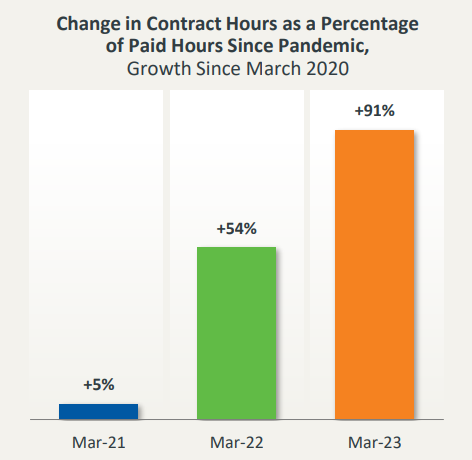Providers hope that AI and better recruitment methods will help solve healthcare's ongoing labor shortage, particularly a severe dearth of nurses, according to a report by consulting company Kaufman Hall.
The increased use of contracted workers helped fuel a 20% growth in labor expenses in the healthcare system from March 2022 to March 2023, the analysis found.
Erik Swanson, a senior vice president with Kaufman Hall’s data analytics department, told Fierce Healthcare that logistical complications prevent an estimate in raw numbers, but labor expenses comprise a little over half of total hospital expenditures, which come to a little less than $1 trillion a year.
“It’s quite a substantial increase in the labor component,” Swanson said.

The study found that healthcare organizations saw a 91% increase in what they pay for contracted labor compared to before the COVID-19 pandemic. They paid just under double the amount for contract labor than they did pre-pandemic, and the bulk of that paid for nurses.
“Right now, about 90% of the total nursing workforce at most organizations is employed, with the remaining 10% being contracted labor,” Swanson said. “But that 10% is quite a bit larger—nearly double—of what it was pre-pandemic. Traditionally, about 96% of nurses would be employed.”
The report also said that the average professional tenure of nurses dropped from 3.6 years in the 12 months prior to February 2020 to 2.8 years in 2023.
“That’s how long, on average, a nurse stayed on the job but, more importantly, stayed with an individual employer,” Swanson said.
The stresses of the pandemic have led to significant attrition in nursing. A recent study found that 100,000 nurses left the field during COVID-19, and 800,000 are likely to follow them out the door by 2027.
Many of the nurses surveyed reported burnout and feeling emotionally drained.
“Just the mental, physical, and emotional aspects forced a lot of them to leave the job,” Swanson said.
In addition, many nurses nearing or hitting retirement age who might have continued working under normal circumstances decided to leave instead, he said.

Health systems spent 27% more from March 2022 to March 2023 on talent acquisition efforts compared to pre-pandemic levels. The wages for nurses remained relatively stable through mid-2021, but they’ve increased steadily since then, according to the report.
Swanson pointed out that the pandemic exacerbated a trend in a declining healthcare labor pool that had been going on for years.
“That workforce shortage is the primary challenge,” Swanson said. “And one way that that workforce shortage is being addressed is the reliance on some of this very expensive type of labor.”
Now, however, Swanson said he sees many healthcare institutions embracing AI as part of an overall solution to the labor shortage. Much of the administrative work, such as billing, is being done digitally, he said.
“ChatGPT is one that most people are familiar with,” Swanson said. “But there are a variety of other language models, many of which are being tuned and designed specifically for the healthcare environment. Many of these can also help with charting, taking notes, filling out paperwork, reading forms.”
AI involves training personnel as well as hiring the sort of technology experts who don’t usually work in hospitals. However, Swanson said AI won’t take the place of nurses.
“Overall, healthcare is a very risk adverse environment,” Swanson said. “The adoption of these technologies is a little bit slower in the healthcare space than in others, but that’s only because the threshold of meeting these requirements is quite high. Nursing is likely to be a bit more resilient against machine learning and AI technologies given the physical hands-on nature that these jobs.”